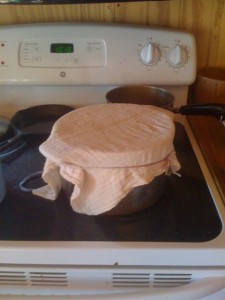 By circumstances beyond my control I have found myself in the cheese making business. Last year my cousin, Libby, made the cheese but since she lost her husband she has not had the energy. I had milk coming out my ears and the cats refused to drink any more. After failing to find anyone to teach me how to make cheese, I took the plunge and ordered the $20 kit from Caprine supply.
By circumstances beyond my control I have found myself in the cheese making business. Last year my cousin, Libby, made the cheese but since she lost her husband she has not had the energy. I had milk coming out my ears and the cats refused to drink any more. After failing to find anyone to teach me how to make cheese, I took the plunge and ordered the $20 kit from Caprine supply.
First step, of course, is milking the goat. Sally is not the easiest goat to milk. When she is eating she is good but when she finishes eating or gets full she kicks over the bucket. She goes from standing perfectly to jumping in the bucket with no warning. I put rocks in her bowl so I have some warning when she is almost done.
The other day she jumped in the bucket and I got fed up. Not only do I lose the milk but it makes a huge mess in the milking area. I have to bring a bucket of water in and wash everything down. So when Sally jumped in the bucket I left her tied and washed the area with her still in it. I explained to her that if she was going to make the mess she could participate in the cleanup. Needless to say, she was not impressed, but since then she has been very polite.
Making cheese is not that hard but it requires attention. First, I have to pasteurize the milk by heating it to 145 degrees and keeping it there for 30 minutes. This is not so easy on an electric stove. With practice I have learned to turn the burner down at the right time so the milk does not overheat. Then I cool the milk down to 72 so I can add the culture. Since I keep my house at 78, I have to use an ice bath to cool the milk.
I had to order a special thermometer that goes low enough and I broke the first one by stirring with it. I must have banged it on the bottom of the pan. Caprine supply took pity on me and sent another at no charge. They are a great company and have lots of direct set cultures that make the cheese making process easy. Another thing I did not figure for the first time was the need for the curds to set up over a 12 to 16 hour period. The first batch I made was ready to separate at about 2 am. Now I time this better.
Once the culture has done it’s thing, I scoop out the curds and put them in a colander lined with butter muslin. This allows the whey to drain off leaving the solid cheese. It takes another 12 or so hours for the cheese to drain. Once you have your soft cheese, you can add herbs, spices etc. You can use a mold or shape the cheese into logs. It is great on crackers, sandwiches or just about anything. I have almost foundered myself eating it.
If you had told me 2 years ago that I would make goat cheese, I would have laughed but I am having fun. Next. Homemade wine! Madalyn
hahahahahahahahahaha! LOVE it!!!!